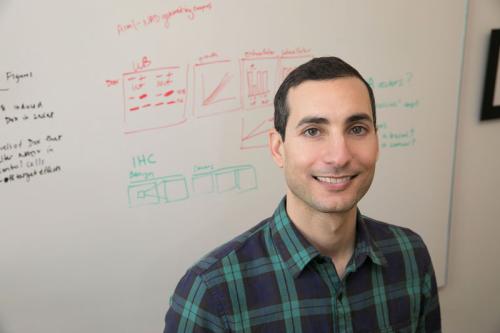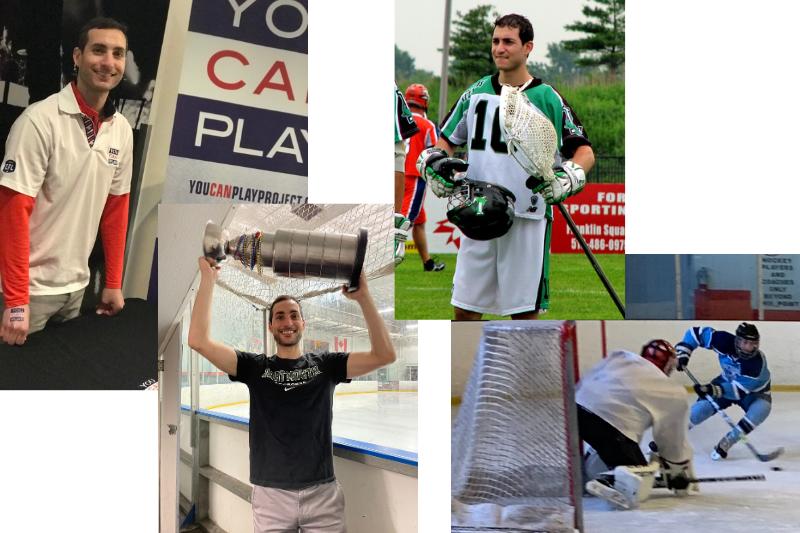
Member Spotlight: Andrew Goldstein’s transition from lacrosse goalie to game-changing cancer researcher
Meet center member Andrew Goldstein, PhD, a prostate cancer researcher, anti-bullying advocate and the first openly gay male athlete to be drafted by a professional sports league. Here, he talks about his early dreams of Broadway, how his background in athletics has shaped his approach to research and his quest to make locker rooms more inclusive.
Goldstein is an associate professor of molecular, cell and developmental biology and of urology at the David Geffen School of Medicine at UCLA. He also serves as chair of the biomedical research minor and is a member of the UCLA Health Jonsson Comprehensive Cancer Center.
Tell us about your research.
My research focuses on the intersection of cancer biology, metabolism, aging and fertility. I have three major interests:
- Developing better models for studying disease initiation. We have very little insight into how a healthy, happy, functioning tissue develops into cancer. Our lab is addressing this knowledge gap by developing new models and optimizing existing ones to better understand that crucial period of time when the disease initiates. From there, we can gain a clearer picture of how the disease evolves and ultimately lay the foundation for new therapies and methods for early disease detection.
- Investigating the effect of metabolism on how tumor cells respond to therapy. The main treatment option for patients with prostate cancer is hormone therapy, which slows the growth of the tumor by lowering the amount of testosterone in the body. However, eventually almost all patients develop resistance to the therapy. We’ve published the two papers that I’m most proud of in my career within the last year on this topic of how cells use energy to influence the way prostate tumors evolve, survive and grow. This work could offer clues to explain why some prostate cancers become resistant to hormone therapy and give researchers more insight into how to make tumors more treatable.
- Exploring the role of the prostate in reproduction. While we know conceptually that the prostate is required for natural reproduction, our team is now digging into the mechanisms of how prostate cells are regulated to find potential ways to not only boost the fertility for those who are struggling to conceive but also inform the development of new contraceptives.
How has being a UCLA Broad Stem Cell Research Center member helped you as a scientist?
As a member of the BSCRC, the access you get to the most brilliant and generous faculty is invaluable. The center has also awarded our lab seed funding that has allowed us to take bold risks and pursue new areas of research. For example, we have a project we’re collaborating on with fellow center member Dr. Christopher Seet. In the past, we’ve had to study human prostate cells in the absence of human immune cells because we didn’t have genetically matched immune cells, preventing us from understanding how these two types of cells interact during disease initiation and progression. Our lab is now using pluripotent stem cells to make prostate cells, while Dr. Seet’s lab is making immune cells from the same pluripotent stem cells. This way, we can put the two types of cells together and they’re genetically matched, which allows us to finally study interactions between prostate epithelial cells and immune cells. I’ve wanted to pursue this idea for some time but didn’t have the funding. Then I got a BSCRC Innovation Award and now it’s one of the coolest projects going on in our lab.
Have you always wanted to be a scientist?
No, although I’ve had science influences in my family — my dad is a physician-scientist and my maternal grandfather was a biochemistry professor — I didn’t really consider a career in science until later in college. When I was very young, I wanted to be a performer on Broadway, which perhaps relates to the way I now give my lectures in class. As I got a little older, I had dreams of becoming an architect and was always designing floor plans and creating little homes.
Fast forward to college, I majored in biochemistry and molecular biology, but I wasn’t sure what I wanted to do with it until a summer internship at the Memorial Sloan Kettering Cancer Center opened up my world to the possibilities of a career in science. After undergrad, I worked as a research technician on the weekdays while playing professional lacrosse on the weekends. It was fun to be a professional athlete for a period, but I had no visions of doing that for the rest of my life. Then I got into graduate school and have stayed on the academic path ever since.
What motivates you to pursue your research?
How many people in the world get to think up an idea, tackle that research question in the lab and then have the answer sometimes within days or weeks? As scientists, we get to do experiments that have never been done in the history of the world. You have to be dead inside to not wake up screaming with enthusiasm at the prospect of a life like that. While it’s true that big progress often happens really slowly in science, getting to dream up questions, solve puzzles all day and fill in these little knowledge gaps is like magic to me.
My background in athletics helps me stay disciplined and find growth opportunities even when something doesn’t go right. As a lacrosse goalie, who in an ideal scenario stops 50% to 60% of shots, it’s important to be flexible and have the ability to bounce back after your opponent scores. Similarly, as a scientist, some days your experiments just aren’t working, or you didn’t get the grant or your paper gets rejected — it’s important to lean into your other skills on those days to make sure you’re still showing up for your team.
Where and when are you the happiest?
At work, I’m happiest when my students are excited about their projects. We have weekly lab meetings during which students share what they’ve been working on. Seeing their enthusiasm, passion and creativity really brings me a lot of joy.
Outside of work, I enjoy playing ice hockey because that’s when I’m able to be completely in the moment. I play in an adult league with the Los Angeles Blades, which is the oldest LGBTQ hockey team in the nation. I’ve played with the same team since I first moved to L.A. in 2006, so my teammates are very much like family at this point. I started ice skating when I was three years old and my dad became my first hockey coach when I was four. The fact that I’m in my 40s and still playing ice hockey is just the best feeling.

What’s something most people might not know about you?
Even though I don’t play lacrosse anymore, I still stay involved with the sport through the work I do with the You Can Play Project, an organization whose aim is to ensure that everyone can enjoy the benefits of playing sports regardless of sexual orientation or gender identity. They bring me in to talk to high schools and colleges about how to make locker rooms more inclusive.
Drawing from my own experiences growing up playing sports, the people who said things that made me feel bad about myself weren’t hateful people, they just weren’t aware that what they were saying could be harmful. So, for me, I’m big on education and spreading awareness about the power of words and the importance of being respectful, considerate and not making assumptions about people.

